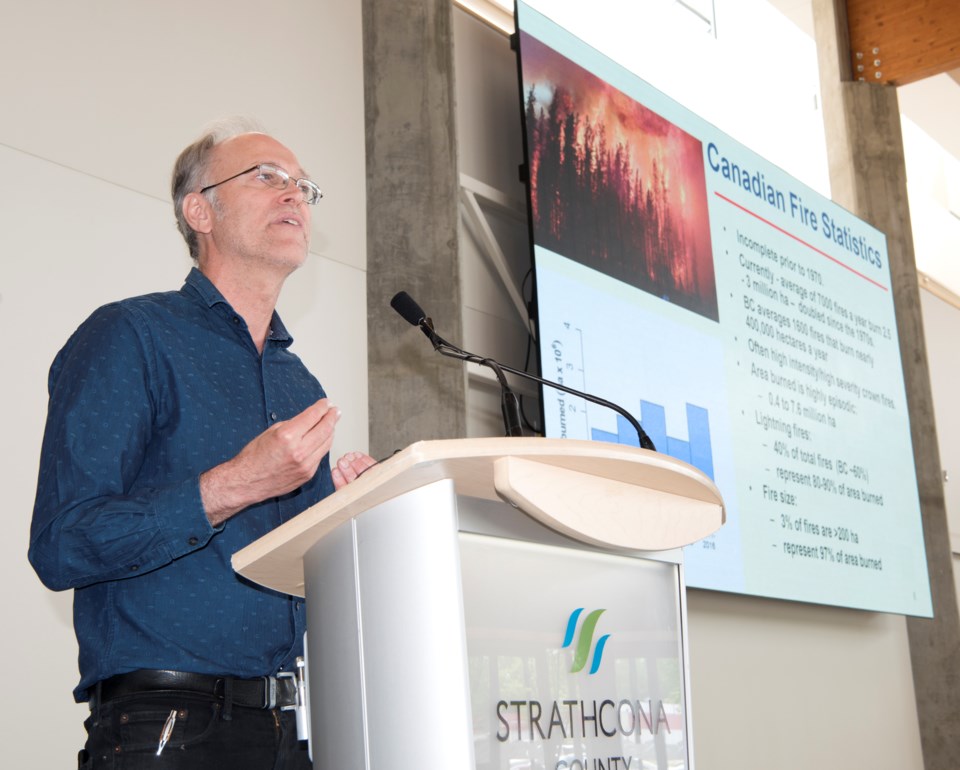Alberta can expect to see twice as much forest fire and up to 12 times more forest fire smoke a year by 2100 because of global heating, says a University of Alberta wildfire expert.
About 70 people were at the Strathcona County Community Centre Thursday for the 2019 Alberta Capital Airshed Clean Air Forum. This year’s session focused on wildfires.
St. Albert doesn’t usually see wildfires near its borders, but it does get the smoke from them, said Alberta Capital Airshed president Brent Korobanik. Take the smoke that blew on May 30, for example, which was so thick that at one point the air quality health index was listed as 72 on what’s normally a 10-point scale (where 1 is good, 10 is really bad, and anything worse than 10 is usually shown as “10+”).
“Wildfires can happen hundreds of kilometres away and have direct impacts on the air we breathe,” Korobanik said, as well as our health.
Particulate matter is one of the biggest health threats in forest fire smoke, said Sarah Henderson, senior scientist for the B.C. Centre for Disease Control. She estimated that a typical “very smoky” day with 100 µg/cubic meters of particulates in the air would cause four extra deaths and 140 more asthma-related doctor’s visits per million people.
Forum-goers learned that particulate levels in parts of Edmonton hit a record 1,880 µg/cubic metre on May 30 due to forest fire smoke.
More heat, more fire
U of A wildland fire professor Mike Flannigan showed forum-goers stats and charts on how Alberta was seeing more forest fires now than it did several decades ago.
“This is because our weather is changing, and it’s (changing) because of human-caused climate change.”
Forest fires need three things to happen, he explained: fuel, ignition and weather. More warmth means more dry fuel in forests, more fire-starting thunderstorms and more fire-spreading winds.
Global heating is bringing that warmth, he continued. Greenhouse gases like CO2 trap heat. We’re now on track to see up to 6 C of warming above pre-industrial levels by 2100 because we’ve cranked more CO2 into the air than has even been there in four million years.
“We have not had a below-normal month (in terms of global temperatures) since December 1984,” he said.
“If that isn’t telling, I don’t know what is.”
More warmth has meant more fire. Alberta’s fire season now starts in March instead of April, while Canada now loses 2.5 million hectares a year to fire instead of the one million it did in the 1970s, Flannigan said. Environment Canada studies have found human-caused global heating made the fire that destroyed Fort McMurray up to six times more likely to occur and caused up to 11 times more land in B.C. to be torched in 2017.
Flannigan said his research suggests Alberta would likely see the amount of land it loses to forest fires each year double by 2100 due to current climate trends. Those fires will burn wider and deeper into the forest floor, which means more smoke – six to 12 times more, he predicted.
What to do about it
We’ll still see more forest fires even if we stop creating heat-trapping pollution today due to the amount that’s already in the climate system, Flannigan said.
“We are going to have more smoke in the future and people are going to have to live with it,” he said – but we can also take steps to protect ourselves from it.
Henderson said staying indoors and limiting physical activity when smoke blows in can reduce your exposure, as can an indoor air filtration system. The Pine Centre Mall in Prince George, B.C., has installed advanced air filters to make itself a “cleaner air shelter ” for people during smoke events, she noted.
In addition to preventing the human-caused fires (which make up 60 per cent of Canada’s wildfires) through fire bans and education, Flannigan said we can reduce our fire risk by passing a carbon tax to reduce heat-trapping pollution.
“This is about being good global citizens,” he said.




